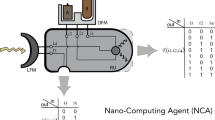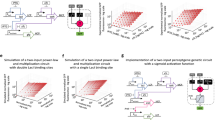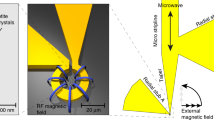Abstract
Natural computers exploit the emergent properties and massive parallelism of interconnected networks of locally active components1,2,3. Evolution has resulted in systems that compute quickly and that use energy efficiently, utilizing whatever physical properties are exploitable4. Man-made computers, on the other hand, are based on circuits of functional units that follow given design rules5,6. Hence, potentially exploitable physical processes, such as capacitive crosstalk, to solve a problem are left out7,8. Until now, designless nanoscale networks of inanimate matter that exhibit robust computational functionality had not been realized. Here we artificially evolve the electrical properties of a disordered nanomaterials system (by optimizing the values of control voltages using a genetic algorithm) to perform computational tasks reconfigurably. We exploit the rich behaviour that emerges from interconnected metal nanoparticles, which act as strongly nonlinear single-electron transistors9,10, and find that this nanoscale architecture can be configured in situ into any Boolean logic gate. This universal, reconfigurable gate would require about ten transistors in a conventional circuit. Our system meets the criteria for the physical realization of (cellular) neural networks11: universality (arbitrary Boolean functions), compactness, robustness and evolvability, which implies scalability to perform more advanced tasks12,13. Our evolutionary approach works around device-to-device variations and the accompanying uncertainties in performance. Moreover, it bears a great potential for more energy-efficient computation, and for solving problems that are very hard to tackle in conventional architectures14,15,16.
This is a preview of subscription content, access via your institution
Access options
Subscribe to this journal
Receive 12 print issues and online access
$259.00 per year
only $21.58 per issue
Buy this article
- Purchase on Springer Link
- Instant access to full article PDF
Prices may be subject to local taxes which are calculated during checkout




Similar content being viewed by others
References
Hopfield, J. J. Neural networks and physical systems with emergent collective computational abilities. Proc. Natl Acad. Sci. USA 79, 2554–2558 (1982).
Watts, D. J. & Strogatz, S. H. Collective dynamics of ‘small-world’ networks. Nature 393, 440–442 (1998).
Wiesenfeld, K. & Moss, F. Stochastic resonance and the benefits of noise: from ice ages to crayfish and squids. Nature 373, 33–36 (1995).
Toffoli, T. Nothing makes sense in computing except in the light of evolution. Int. J. Unconv. Comput. 1, 1–29 (2005).
Goldstine, H. H. & Von Neumann, J. in John von Neumann Collected Works Vol. 5 (ed. Taub, A. H.) 1–32 (Macmillan, 1963).
Turing, A. M. On computable numbers, with an application to the Entscheidungsproblem. J. Math. 58, 345–363 (1936).
Conrad, M. The Price of Programmability (Springer, 1995).
Lloyd, S. Ultimate physical limits to computation. Nature 406, 1047–1054 (2000).
Likharev, K. K. Single-electron devices and their applications. Proc. IEEE 87, 606–632 (1999).
Wasshuber, C. Computational Single-Electronics (Springer, 2001).
Dogaru, R. Universality and Emergent Computation in Cellular Neural Networks (World Scientific Series on Nonlinear Science Series A 43, World Scientific, 2003).
Bandyopadhyay, S. & Roychowdhury, V. Computational paradigms in nanoelectronics: quantum coupled single electron logic and neuromorphic networks. Jpn. J. Appl. Phys. 35, 3350–3362 (1996).
Asai, T. & Oya, T. in Artificial Life Models in Hardware (eds Adamatzky, A. & Komosinski, M.) 133–159 (Springer, 2009).
Likharev, K. K. & Korotkov, A. N. Single-electron parametron: reversible computation in a discrete-state system. Science 273, 763–765 (1996).
Feynman, R. P. Simulating physics with computers. Int. J. Theor. Phys. 21, 467–488 (1982).
Siegelmann, H. T. & Sontag, E. D. Analog computation via neural networks. Theor. Comput. Sci. 131, 331–360 (1994).
Yoshihito, A. Information processing using intelligent materials—information-processing architectures for material processors. J. Intel. Mater. Syst. Str. 5, 418–423 (1994).
Miller, J. F. & Downing, K. in Proceedings of the 2002 NASA/DOD Conference on Evolvable Hardware 167–176 (IEEE, 2002).
Miller, J. F., Harding, S. L. & Tufte, G. Evolution-in-materio: evolving computation in materials. Evol. Intel. 7, 49–67 (2014).
Tour, J. M. et al. Nanocell logic gates for molecular computing. IEEE Trans. Nanotechnol. 1, 100–109 (2002).
Chen, R. H., Korotkov, A. N., & Likharev, K. K. Single-electron transistor logic. Appl. Phys. Lett. 68, 1954–1956 (1996).
Nakajima, F., Miyoshi, Y., Motohisa, J. & Fukui, T. Single-electron AND/NAND logic circuits based on a self-organized dot network. Appl. Phys. Lett. 83, 2680–2682 (2003).
Maeda, K. et al. Logic operations of chemically assembled single-electron transistor. ACS Nano 6, 2798–2803 (2012).
Heath, J. R., Kuekes, P. J., Snider, G. S. & Williams, R. S. A defect-tolerant computer architecture: opportunities for nanotechnology. Science 280, 1716–1721 (1998).
Snider, G. S. & Williams, R. S. Nano/CMOS architectures using a field-programmable nanowire interconnect. Nanotechnology 18, 035204 (2007).
Merolla, P. A. et al. A million spiking-neuron integrated circuit with a scalable communication network and interface. Science 345, 668–673 (2014).
Kirkpatrick, S., Gelatt, C. D. & Vecchi, M. P. Optimization by simulated annealing. Science 220, 671–680 (1983).
Holland, J. H. Adaptation in Natural and Artificial Systems: An Introductory Analysis with Applications to Biology, Control, and Artificial Intelligence (Univ. Michigan Press, 1975).
Valiant, L. G. Evolvability. JACM 56, 3 (2009).
Rodríguez-Vázquez, A. et al. ACE16k: the third generation of mixed-signal SIMD-CNN ACE chips toward VSoCs. IEEE Trans. Circuits Syst. I 51, 851–863 (2004).
Pohl, H. A. Dielectrophoresis: the Behavior of Neutral Matter in Nonuniform Electric Fields (Cambridge Monographs in Physics, 80, Cambridge Univ. Press, 1978).
Bernard, L., Calame, M., van der Molen, S., Liao, J. & Schönenberger, C. Controlled formation of metallic nanowires via Au nanoparticle ac trapping. Nanotechnology 18, 235202–235207 (2007).
Acknowledgements
We thank A.-J. Annema, M. Danish, J. Huskens, S. Intan, M. de Jong, J. Mikhal, B. Nauta, D. Reinhoudt, I. Rianasari, E. Strambini, F. Zwanenburg and all the collaborators of the NASCENCE project for fruitful discussions. We acknowledge financial support from MESA+, CTIT, the European Community's Seventh Framework Programme (FP7/2007–2013) under grant agreement No. 317662 and the European Research Council, ERC Starting Grant No. 240433.
Author information
Authors and Affiliations
Contributions
S.K.B. and C.P.L. fabricated the samples, carried out the experiments and performed the data analysis. C.P.L. designed and programmed the genetic search algorithm. R.M.J.v.D. contributed with theoretical inputs. W.G.v.d.W. conceived the experiments, and planned and supervised the project. H.J.B. conceived the project together with W.G.v.d.W. and cosupervised. Z.L. and K.S.M. contributed to the sample fabrication. All the authors discussed the results, provided important insights and helped write the manuscript.
Corresponding author
Ethics declarations
Competing interests
The authors declare no competing financial interests.
Supplementary information
Supplementary information
Supplementary Information (PDF 4961 kb)
Rights and permissions
About this article
Cite this article
Bose, S., Lawrence, C., Liu, Z. et al. Evolution of a designless nanoparticle network into reconfigurable Boolean logic. Nature Nanotech 10, 1048–1052 (2015). https://doi.org/10.1038/nnano.2015.207
Received:
Accepted:
Published:
Issue Date:
DOI: https://doi.org/10.1038/nnano.2015.207
This article is cited by
-
Toward a formal theory for computing machines made out of whatever physics offers
Nature Communications (2023)
-
Tomography of memory engrams in self-organizing nanowire connectomes
Nature Communications (2023)
-
Double gate operation of metal nanodot array based single electron device
Scientific Reports (2022)
-
A distributed nanocluster based multi-agent evolutionary network
Nature Communications (2022)
-
In materia reservoir computing with a fully memristive architecture based on self-organizing nanowire networks
Nature Materials (2022)



